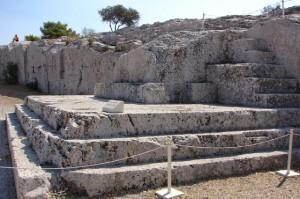 |
|
Pnyx: Orator's Bema
|
The discovery by Pittakis in 1835 of a boundary stone of the 5th century B.C. inscribed "HOPOΣ ΠΥKNOΣ", "boundary of the Pnyx" led to the definitive identification of the extensive structures at the crest of the Hill of the Pnyx as the site of the assembly place. Zeus as protector of the state (Altar of Zeus Agoraios) and as healer (Shrine of Zeus Hypsistos) received the prayers of the assembly before the sessions began.
The Assembly (Ekklesia) of the People met ten times a year; there the Chairman of the Prytaneis presided, assisted by a Secretary and a Herald, who made the announcements. The audience sat originally on the bedrock but later on wooden benches, while the orator spoke from the bema (speaker's platform). At a lower level of this bema sat the Prytaneis, who, assisted by archers, kept order. From the bema of the Pnyx famous politicians and orators such as Themistokles, Perikles, Demosthenes and Aischines addressed the Athenians.
The area, a semicircular amphitheatre in shape, 70m. in depth and 120m. in diameter and with a strong retaining wall that supported its perimeter, shows three construction stages:
Ist stage: (6th century B.C., in the first years of the Athenian Democracy). The cavea had room for ca. 5.000 persons. The bema was in the north and the audience faced the Agora, the Areopagus and the Propylaia
2nd stage: (Late 5th century B.C.). The orientation of the cavea was changed, with the bema now in the southwest and with a new retaining wall (1) with two staircases for access. The seating capacity was increased to 6.000
3rd stage: (down to around 300-326 B.C., during the ambitious building program of Lykourgos). The capacity was again increased, to 13,500, and a new monumental retaining wall was added with a central staircase for access (2). Across from the entrance was a bema carved into a huge piece of bedrock, "the Stone", with a facade of 9m. and three steps 1.10m. high (4). Higher up there was the president's box and behind it the altar of Zeus Agoraios (9) and the solar clock of the astronomer Meton (15); east of the bema stood the shrine of Zeus Hypsistos, against the face of the rock, which had niches carved into it (8). During the architectural reform of Lykourgos, two long Stoas were intended to be built in the west and south side of the assembly place, providing shelter to the citizens. Both buildings were left unfinished and were later incorporated in the Diateichisma.
The Pnyx was abandoned at the end of the 4th century B.C., when the public meeting-place was transferred to the more suitable place of the Theater of Dionysos. |



